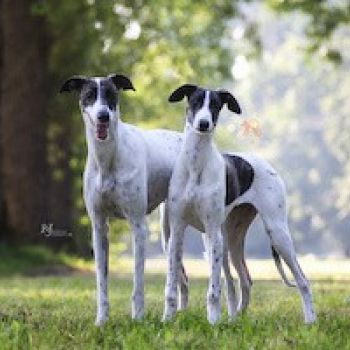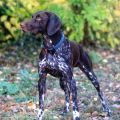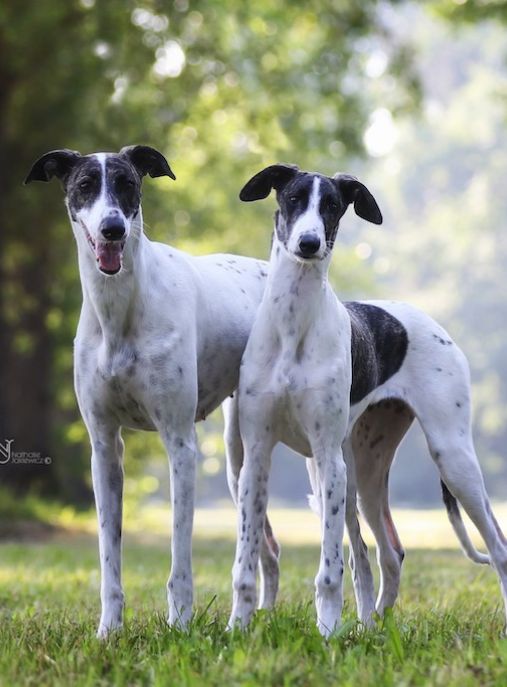The Hungarian Greyhound, also known as the Magyar Agar, is a stunning and elegant dog breed that has captivated the hearts of many dog enthusiasts around the world. With its sleek and slender physique, this breed is often compared to a greyhound, but it possesses its own unique characteristics that set it apart.
Originating from Hungary, the Hungarian Greyhound has a rich history that dates back centuries. This breed is believed to have descended from ancient Eastern sighthounds, which were brought to Hungary by nomadic tribes. Over time, these dogs were selectively bred to create a breed that excelled in hunting and coursing.
According to the FCI (Fédération Cynologique Internationale) typology, the Hungarian Greyhound belongs to Group 10, which includes sighthounds. This group consists of dogs that are known for their exceptional speed, agility, and keen eyesight. Within Group 10, the Hungarian Greyhound falls under Section 3, which includes the short-haired sighthounds.
The Hungarian Greyhound is primarily a hunting dog, specifically bred for coursing and chasing game. Its incredible speed and agility make it an excellent choice for hunting small game, such as hares and foxes. However, this breed is also highly valued as a companion and family pet due to its gentle and affectionate nature.
In terms of physical characteristics, the Hungarian Greyhound is a medium-sized dog with a well-muscled body. Males typically stand between 24 to 27 inches (60 to 70 cm) at the shoulder, while females are slightly smaller, ranging from 22 to 25 inches (55 to 65 cm). The weight of this breed usually falls between 50 to 70 pounds (23 to 32 kg).
One of the most striking features of the Hungarian Greyhound is its sleek and smooth coat, which comes in a variety of colors including black, fawn, brindle, and various shades of gray. The coat is short and dense, providing protection against the elements while requiring minimal grooming.
The life expectancy of the Hungarian Greyhound is around 12 to 14 years, which is relatively long for a sighthound breed. This breed is generally healthy, but like any dog, it can be prone to certain health issues such as bloat, hip dysplasia, and progressive retinal atrophy. Regular exercise, a balanced diet, and routine veterinary care are essential to ensure the overall well-being of this breed.
Despite its hunting background, the Hungarian Greyhound is known for its gentle and affectionate nature. It forms strong bonds with its family and thrives on human companionship. This breed is generally good with children and can coexist peacefully with other pets if properly socialized from a young age.
The Hungarian Greyhound is an intelligent and trainable breed, although it may have an independent streak at times. Positive reinforcement training methods work best with this breed, as they respond well to praise and rewards. Mental stimulation and regular exercise are crucial to prevent boredom and destructive behaviors.
Due to its exceptional speed and agility, the Hungarian Greyhound excels in various dog sports such as lure coursing, agility, and obedience trials. These activities not only provide physical exercise but also stimulate the dog's mind, allowing it to showcase its natural abilities.
In conclusion, the Hungarian Greyhound, or Magyar Agar, is a remarkable dog breed with a rich history and exceptional hunting abilities. Its sleek and elegant appearance, coupled with its gentle and affectionate nature, make it a beloved companion and family pet. Whether as a hunting partner or a loyal friend, the Hungarian Greyhound is sure to leave a lasting impression on anyone fortunate enough to encounter this magnificent breed.
The Hungarian Greyhound, also known as the Magyar Agar, is a breed of dog that possesses a unique and captivating character. These dogs are known for their elegance, agility, and loyalty, making them a popular choice for dog enthusiasts around the world. In this text, we will delve into the character of Hungarian Greyhounds, exploring their behavior, how to raise them, and the best training methods for this breed.
One of the most prominent characteristics of Hungarian Greyhounds is their gentle and affectionate nature. They are incredibly loyal to their owners and form strong bonds with their families. These dogs thrive on human companionship and are known to be excellent family pets. They are gentle with children and get along well with other dogs, making them a great addition to multi-pet households.
Despite their gentle nature, Hungarian Greyhounds possess a strong prey drive due to their sighthound heritage. They have a natural instinct to chase small animals, so it is important to provide them with a secure and fenced-in area to prevent any potential accidents. It is also advisable to keep them on a leash during walks to ensure their safety and the safety of other animals.
Hungarian Greyhounds are highly intelligent and eager to please, which makes them relatively easy to train. However, they can also be independent and stubborn at times, so consistent and patient training methods are essential. Positive reinforcement techniques, such as treats, praise, and rewards, work best with this breed. Harsh training methods or punishment can lead to fear or anxiety, which may hinder their progress.
Socialization is crucial for Hungarian Greyhounds from an early age. Exposing them to various environments, people, and other animals will help them develop into well-rounded and confident dogs. Puppy classes and obedience training are highly recommended to ensure they learn proper manners and become well-behaved companions.
Exercise is vital for Hungarian Greyhounds as they are an active breed. They require daily physical and mental stimulation to prevent boredom and destructive behaviors. Long walks, jogging, and playtime in a secure area are ideal for meeting their exercise needs. Mental stimulation can be achieved through puzzle toys, obedience training, and interactive games.
It is important to note that Hungarian Greyhounds are sensitive dogs and thrive in a calm and harmonious environment. They are highly attuned to their owner's emotions and can become anxious or stressed if exposed to constant tension or loud noises. Providing them with a peaceful and stable home will contribute to their overall well-being.
In conclusion, Hungarian Greyhounds are gentle, loyal, and intelligent dogs that make wonderful family pets. They require consistent training, socialization, and exercise to thrive and be well-adjusted companions. With the right care and attention, these elegant dogs will bring joy and love to their owners' lives for many years to come.
The Hungarian Greyhound, also known as the Magyar Agar, is a beautiful and elegant breed that requires specific care to ensure their well-being and happiness. Here are some tips on how to care for Hungarian Greyhounds, including what to do and what not to do:
1. Exercise: Hungarian Greyhounds are active dogs that require regular exercise to maintain their physical and mental health. Daily walks or jogs are essential to keep them fit and prevent boredom. However, avoid excessive exercise, especially in hot weather, as they are sensitive to heat and can easily overheat.
2. Grooming: The Hungarian Greyhound has a short, dense coat that requires minimal grooming. Regular brushing with a soft bristle brush will help remove loose hair and keep their coat shiny. Bathing should be done only when necessary, using a mild dog shampoo to avoid skin irritation.
3. Diet: Provide a balanced and nutritious diet to meet the specific needs of Hungarian Greyhounds. High-quality dog food, preferably formulated for large breeds, is recommended. Avoid overfeeding, as this breed is prone to obesity. Consult with a veterinarian to determine the appropriate portion sizes and feeding schedule.
4. Socialization: Hungarian Greyhounds are known for their gentle and affectionate nature. It is crucial to socialize them from an early age to ensure they are comfortable around people, other animals, and different environments. Expose them to various situations, sounds, and experiences to prevent shyness or fearfulness.
5. Mental Stimulation: These intelligent dogs thrive on mental stimulation. Engage them in activities that challenge their minds, such as puzzle toys, obedience training, or agility exercises. This will prevent boredom and destructive behavior.
6. Health Care: Regular veterinary check-ups are essential to monitor the overall health of your Hungarian Greyhound. Vaccinations, parasite prevention, and dental care should be maintained according to the veterinarian's recommendations. Additionally, be aware of common health issues in this breed, such as bloat, heart problems, and hip dysplasia.
7. Safety: Hungarian Greyhounds have a strong prey drive and can be easily distracted by small animals. It is crucial to keep them on a leash or in a securely fenced area to prevent them from chasing or escaping. Ensure your home and yard are dog-proofed, removing any potential hazards or toxic substances.
8. Temperature Control: Hungarian Greyhounds have thin skin and a lack of body fat, making them sensitive to extreme temperatures. During hot weather, provide shade, fresh water, and avoid exercising them during the hottest parts of the day. In cold weather, provide them with a warm coat or sweater to keep them comfortable.
9. Emotional Well-being: Hungarian Greyhounds are sensitive and thrive on human companionship. They are not suited for long periods of isolation or being left alone for extended periods. Ensure they receive plenty of love, attention, and mental stimulation to prevent separation anxiety or destructive behavior.
What not to do:
1. Do not leave your Hungarian Greyhound alone for long periods regularly.
2. Avoid overfeeding or providing an unbalanced diet, as this can lead to obesity and related health issues.
3. Do not skip regular veterinary check-ups or neglect their vaccinations and parasite prevention.
4. Avoid excessive exercise, especially in hot weather, as they are prone to overheating.
5. Do not use harsh training methods or punishment, as Hungarian Greyhounds respond best to positive reinforcement and gentle guidance.
By following these tips and providing proper care, you can ensure that your Hungarian Greyhound lives a happy, healthy, and fulfilling life.
The Hungarian Greyhound, also known as the Magyar Agar, is a stunning breed that possesses a unique and captivating coat color. The common color of these dogs is a mesmerizing combination of various shades of gray, which gives them an elegant and distinguished appearance.
The base color of the Hungarian Greyhound's coat is typically a medium to dark shade of gray. This primary hue is often described as a rich and lustrous color that exudes a sense of sophistication. The gray tone can vary slightly from dog to dog, with some individuals displaying a lighter shade, resembling silver, while others may have a deeper charcoal or slate gray coloration.
One of the most striking features of the Hungarian Greyhound's coat is the presence of subtle variations and patterns within the gray color. These variations can manifest as lighter or darker patches, creating a beautiful and intricate mosaic-like effect. These patterns are often seen on the dog's back, sides, and legs, adding depth and dimension to their overall appearance.
In addition to the base gray color, Hungarian Greyhounds may also exhibit other secondary colors that further enhance their unique coat. It is not uncommon to find dogs with small patches of white or black on their chest, paws, or tail. These contrasting colors create a striking contrast against the predominant gray, making the Hungarian Greyhound even more visually appealing.
The texture of the Hungarian Greyhound's coat is another noteworthy aspect. It is typically short, smooth, and sleek, accentuating the breed's graceful and athletic physique. This coat type not only enhances their overall appearance but also provides them with protection against various weather conditions.
The color of the Hungarian Greyhound's eyes and nose complements their gray coat perfectly. Their eyes are usually dark and expressive, ranging from deep brown to black, adding a touch of intensity to their gaze. The nose is typically black, harmonizing with the overall color scheme and completing the elegant look of these dogs.
In conclusion, the common color of Hungarian Greyhound (Magyar Agar) dogs is a captivating and multi-dimensional shade of gray. The various nuances and patterns within this color create a visually stunning coat that is both sophisticated and unique. Combined with their sleek physique and expressive eyes, the Hungarian Greyhound's coat color contributes to their overall charm and allure.
The Hungarian Greyhound, also known as the Magyar Agar, is a magnificent breed known for its elegance, agility, and speed. These dogs have a generally robust health, but like any other breed, they are prone to certain diseases. To ensure the well-being of your Hungarian Greyhound, it is essential to understand the common health issues they may face and provide appropriate care.
One of the most common health concerns in Hungarian Greyhounds is hip dysplasia. This condition occurs when the hip joint doesn't develop properly, leading to discomfort, lameness, and arthritis. Regular exercise on soft surfaces, maintaining a healthy weight, and providing joint supplements can help manage this condition. Additionally, breeding dogs should undergo hip evaluations to reduce the risk of passing on this genetic condition.
Another prevalent health issue in Hungarian Greyhounds is bloat, also known as gastric dilatation-volvulus (GDV). This is a life-threatening condition where the stomach twists, causing gas buildup and cutting off blood supply. To prevent bloat, it is recommended to feed your dog smaller, frequent meals, avoid vigorous exercise immediately after meals, and use elevated feeding bowls. If you notice symptoms like restlessness, unproductive vomiting, or a distended abdomen, seek immediate veterinary attention.
Dental problems are also common in Hungarian Greyhounds. Regular dental care, including brushing their teeth, providing dental chews, and scheduling professional cleanings, can help prevent periodontal disease and maintain good oral health.
As a sighthound breed, Hungarian Greyhounds are susceptible to eye issues such as progressive retinal atrophy (PRA) and cataracts. Regular eye examinations by a veterinary ophthalmologist are crucial to detect and manage these conditions. Additionally, protecting their eyes from debris and UV rays with doggy goggles during outdoor activities can help prevent injuries and reduce the risk of developing eye problems.
Like many large breeds, Hungarian Greyhounds can also suffer from dilated cardiomyopathy (DCM), a condition that affects the heart muscle's ability to pump blood effectively. Regular veterinary check-ups, a balanced diet, and appropriate exercise can help maintain cardiovascular health. If your dog shows symptoms like coughing, fatigue, or difficulty breathing, consult a veterinarian promptly.
To ensure the overall health of your Hungarian Greyhound, a balanced diet is essential. Provide high-quality dog food that meets their nutritional needs, considering their age, activity level, and any specific dietary requirements. Regular exercise is also crucial to keep them physically and mentally stimulated. However, avoid excessive exercise during extreme weather conditions to prevent overheating or hypothermia.
Regular veterinary check-ups are vital to detect any potential health issues early on. Vaccinations, parasite prevention, and routine blood tests should be part of their healthcare regimen. Grooming your Hungarian Greyhound regularly, including brushing their short coat, checking their ears for infections, and trimming their nails, will help maintain their overall well-being.
In conclusion, Hungarian Greyhounds are generally healthy dogs, but they can be prone to certain conditions such as hip dysplasia, bloat, dental problems, eye issues, and dilated cardiomyopathy. By providing proper care, including regular veterinary check-ups, a balanced diet, exercise, and preventive measures, you can ensure your Hungarian Greyhound leads a happy and healthy life.
The Hungarian Greyhound, also known as the Magyar Agar, is a beautiful and athletic breed that requires a well-balanced and nutritious diet to maintain its health and energy levels. Proper nutrition is crucial for these dogs to thrive and lead an active lifestyle. In this text, we will provide an extensive description of the nutrition requirements for Hungarian Greyhounds, along with advice on what and how to feed them, as well as things to avoid.
First and foremost, it's important to understand that every dog is unique, and their nutritional needs may vary based on factors such as age, weight, activity level, and overall health. Consulting with a veterinarian is always recommended to tailor a specific diet plan for your Hungarian Greyhound.
Protein is a vital component of a Hungarian Greyhound's diet. High-quality animal-based proteins, such as lean meats (chicken, turkey, beef) and fish, should make up a significant portion of their meals. These proteins provide essential amino acids that support muscle development and repair. It is advisable to feed them a diet that consists of at least 25-30% protein.
Carbohydrates are another important energy source for Hungarian Greyhounds. Opt for complex carbohydrates like whole grains (brown rice, oats) and vegetables (sweet potatoes, carrots, green beans). These provide fiber, vitamins, and minerals while helping to maintain stable blood sugar levels. Carbohydrates should make up around 50% of their diet.
Healthy fats are beneficial for Hungarian Greyhounds, as they provide energy and support their skin and coat health. Incorporate sources of omega-3 fatty acids, such as fish oil or flaxseed oil, into their diet. However, it's important to monitor fat intake to prevent obesity, as Greyhounds can be prone to weight gain.
Feeding frequency is another crucial aspect to consider. Hungarian Greyhounds are prone to bloat, a potentially life-threatening condition. To minimize the risk, it is recommended to feed them smaller meals multiple times a day rather than one large meal. Dividing their daily food intake into two to three meals is ideal.
While it's essential to provide a balanced diet, there are certain foods that should be avoided for Hungarian Greyhounds. These include:
1. Foods high in sodium: Excessive salt intake can lead to dehydration and kidney problems. Avoid feeding them salty snacks or processed foods.
2. Foods toxic to dogs: Chocolate, grapes, raisins, onions, garlic, and certain nuts can be toxic to dogs and should never be included in their diet.
3. Fatty and fried foods: These can lead to weight gain and digestive issues. Avoid feeding them greasy leftovers or fried snacks.
4. Raw or undercooked meat: Raw meat can contain harmful bacteria that may cause foodborne illnesses. Always ensure that meat is cooked thoroughly before feeding it to your Hungarian Greyhound.
5. Excessive treats: While treats can be used for training and rewards, overfeeding treats can lead to weight gain and nutritional imbalances. Choose healthy, low-calorie treats and use them in moderation.
In conclusion, providing a well-balanced and nutritious diet is essential for the overall health and well-being of Hungarian Greyhounds. A diet rich in high-quality proteins, complex carbohydrates, and healthy fats, along with proper feeding frequency, will help them maintain optimal health and energy levels. Always consult with a veterinarian to create a personalized diet plan for your Hungarian Greyhound, and avoid feeding them foods that can be harmful or lead to weight gain.






